Jamie Feaster is not your traditional pothead.
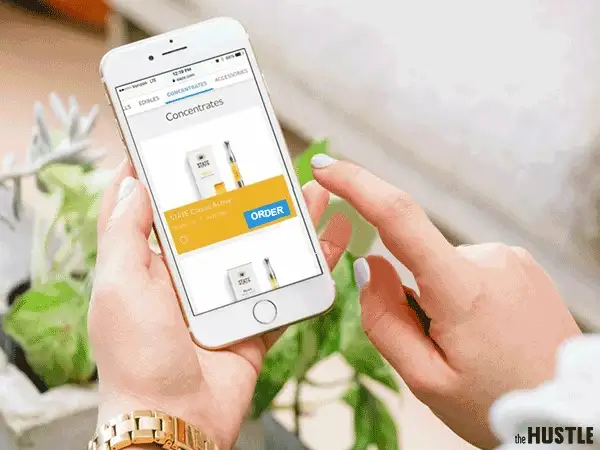
Fitted in a button-down and chinos, he looks more like a finance bro on casual Friday as he rattles off the nuances of various weed strains; “I’m partial to Grandaddy Purp,” he tells me.
And Eaze, the weed delivery platform he helped popularize across California, is not your traditional marijuana company.
In the past 4 years, Eaze has used a barely-legal market to its advantage, raising $52m to serve 100+ California cities and 500k+ users — all without being able to legally advertise (or physically handle) their core product.
Now, in the wake of California’s weed legalization, and with national legalization looming, Eaze has its eyes on a new goal: to be the first household name in cannabis.
I spoke with the recently-departed VP of Marketing at Eaze about his journey with the company and its mission to make marijuana mainstream. Much like a typical stoner flick, it begins with a chance encounter that would set Jamie Feaster on a quest of epic proportions.
Spaced Mountain
Feaster grew up a serious student and 3-sport athlete. In Vacaville, CA, a small city 30 miles southeast of Sacramento, he had minimal exposure to the devil’s lettuce.
Like most high schoolers, Feaster thought weed was all the same — something green you smoked out of a Pepsi can. But that all changed in 2008 when he was a junior at the University of California, Davis, and a friend’s brother invited him to tour the fruits of his grow operation.
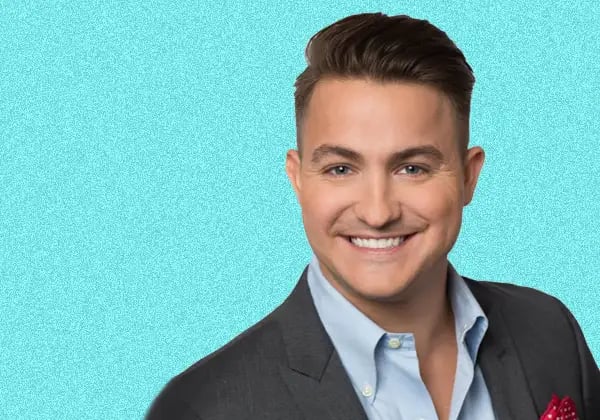
“I kind of got my mind blown,” Feaster recalls. “You have this beautiful Grandaddy Purple with its tight nug structure — really aromatic — and you got this Master Kush, which is green with these orange hairs…”
Feaster became infatuated with the green arts, but he never imagined he could make a living out of it.
Then, in 2013, the budding tech marketer went on trip to Disney World with his family. He and his brother fortuitously struck up a conversation with a man who claimed to be creating “the Uber of weed.”
That man was Eaze founder Keith McCarty.
One of the founding members of internal messaging platform Yammer, McCarty was tech royalty. With his cohort, he’d sold his startup to Microsoft for $1.2B in June 2012, just 4 years after launching.
McCarty told Feaster that he’d already assembled a team of developers to work on an app and had found a way to circumvent the regulatory setbacks most weed companies faced. By positioning the service as a “technology platform,” the app would help dispensaries accept orders, manage their own driver fleets, and process deliveries.
Eaze would take a cut of the process in the form of a “technology fee,” all without handling a single gram.

While McCarty had the technical chops, he knew nothing about weed — and Feaster saw his opening. “I love weed, I know weed,” he promised 25-year-old McCarty. “I’m also a marketing guy. You need me.”
A few drinks later, the brothers found themselves riding Space Mountain “smoking a big vape pen” and pitching McCarty (a non-smoker) ideas like a referral program called ‘Buds for Buds.’
After months of courting McCarty over email and in-person meetings, Feaster became Eaze’s first business hire — fittingly, on 4/20/2014.
With a San Francisco launch less than 3 months away, Feaster was tasked with marketing the unmarketable. How would he grow a company when traditional paid ad channels were illegal?
Like lighting a wet joint…
To get the word out about Eaze, Feaster had to get creative.
Though medical marijuana was legal in CA, it was (and still is) a Schedule I narcotic on a federal level, treated on par with cocaine and heroin in the eyes of the law. Most advertising methods available to traditional startups were off limits: both Facebook and Google banned advertisements for illicit drugs, and advertising on billboards and buses was still in a grey area.
Instead, Eaze would have to rely on the community to drive new users, using ambassadors, a referral program, free t-shirts, “weed-fluencers,” and email marketing with subject lines like “What Was Shakespeare Smoking?”
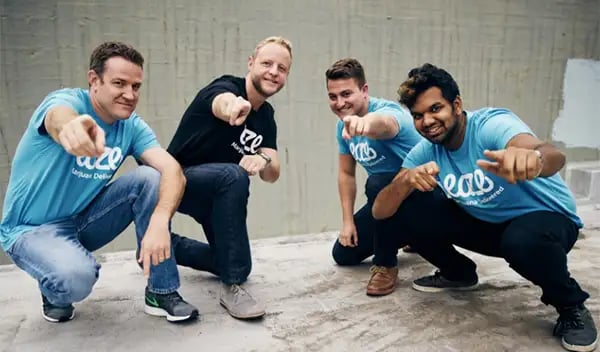
Luckily for Eaze, the business model was a PR goldmine. When Eaze launched in July 2014, news outlets had a field day. Jimmy Kimmel even riffed on the premise in the opening segment of ‘Jimmy Kimmel Live!’.
That publicity boost drove about 100 deliveries in the month of July. After that, their community-based marketing strategy really began to take off. By the time they raised their first $1.5m in seed funding, Eaze was averaging close to 100 deliveries a day.
About 6 months in, Eaze had earned its first $1m in revenue — and by the end of the company’s first year (2015), they had over 100k users and a fresh $10m in Series A funding.
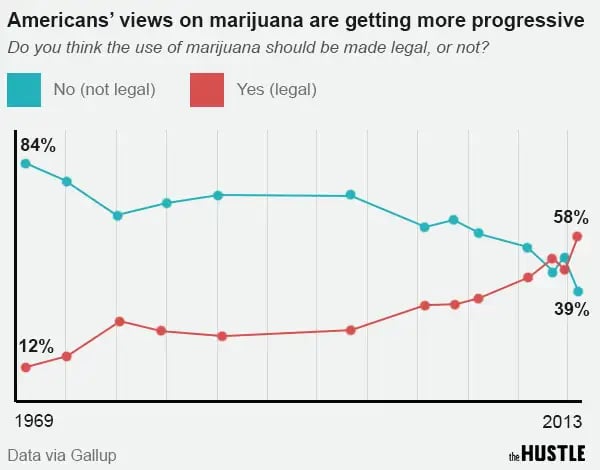
Culturally, Eaze’s, timing couldn’t have been better: by 2013, 58% of the public was in favor of legalization, up from a mere 12% when Gallop first posed the question in 1969.
But, it wasn’t just about striking when the bowl was hot; Feaster knew if they wanted to win the mainstream consumer, they had to revamp reefer’s image.
Countering counterculture
Aside from the occasional pipe carved out of an apple, popular weed culture doesn’t exactly reflect a picture of health and innovation.
So, Feaster dedicated a team, “Eaze Insights,” to craft the narrative around the electric cabbage with stereotype-busting stats (in 2017, nearly 50% of Eaze users had a BA degree and made over $75k a year).
He wanted to “show people the future of weed.” That meant no black and green branding, no pot leaf sweatpants, no hazy lounges. Instead, Eaze’s brand would be blue and white, bright and friendly, featuring promo pictures of happy hikers, and, most importantly, no smoke.
It also meant keeping Eaze’s brand at the forefront, from order to delivery. “We don’t highlight the dispensaries,” Feaster explained. “We own the customer. We’re creating the first household name [for weed].”
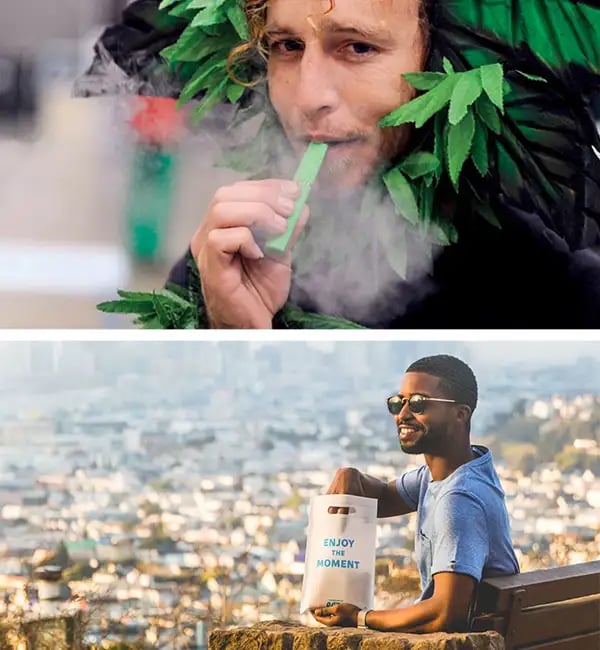
In early 2016, the tides finally shifted: Prop 64 passed in California. Starting January 1st, 2018, recreational marijuana was legal. The tantalizing $3.7B CA weed market earned Eaze another $40m in funding as they grew to $18m in annual revenue.
Emboldened, Jamie went all-in on the marketing campaign his legal team had been vetoing for the past 2 years: seemingly overnight, the company blanketed San Francisco’s city buses and billboards in bright blue, with the slogan “Marijuana has arrived.”
The success came with its share of growing pains. That same year, McCarty stepped down as CEO for “personal reasons,” and the team tripled in size.
Suddenly, Feaster didn’t recognize the company. “We got more conservative… buttoned up,” he sighed. “We were working so closely with regulators, we couldn’t really do the tongue-in-cheek stonery things anymore.”They were also burning through nearly $1m a month and operating at a loss to acquire users, subsidize driver costs, and “not to get run over” by competitors. But as their fame and funding grew, so did the backlash from weed ‘preservationists.’ People “didn’t see all the good we were doing,” Jamie recalls.
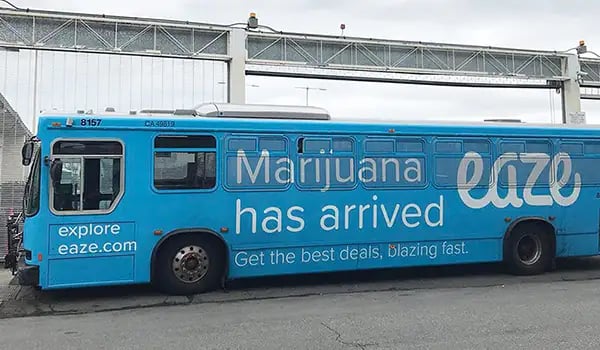
And with legalization came regulation. Starting last January, Eaze could only work with “licensed dispensaries,” but understaffed local regulators could only process a couple of permits a week, with backlogs of thousands. Delivery times skyrocketed and the bottleneck forced Eaze to shut down temporarily in January while they got in compliance.
Undeterred, they were soon back up and running. Their user growth exploded yet again, and all seemed well with the weed world. But when the keef settled, Feaster realized his baby had grown up.
These days, things are different…
Post-legalization, Eaze can only work with large dispensaries that have the infrastructure to be compliant and the scale to make deliveries efficient (currently, only 2 fit the bill in San Francisco).
The “green rush” has left the weed world divided. “There are dispensaries that are like ‘Fuck the man, I don’t want to be a big corporation,’” Feaster says. “And then there are people [who] are trying to strike on an opportunity.”
Now at 180 employees (mostly engineers), the company operates under new leadership, with updated positioning focused on social good. In 2020, they aim to become profitable and sell $1B worth of weed.
Eaze will continue the same way it’s survived the last tumultuous 4 years — by evolving. In this lush new market landscape, it has no other choice. “Those [who] try to keep things as they were will not survive,” Feaster warned. “People are going to have to adapt. Adapt or die.”
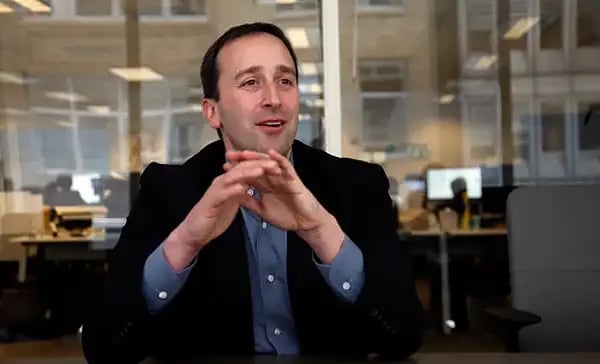
The same goes for him. Feaster left the company about 3 months ago, after his shares fully vested. Now he’s consulting for various weed and tech startups — and he’s just about due for a trip to The Magic Kingdom.
Die a hippie, or live long enough to see yourself become The Man
Picture a world where buying weed is like grabbing a bottle of wine for a dinner party — a chore, convenient at best, tedious at worst.
This is the future Feaster imagines. A future in which weed is a commodity, with big brand-names available across the country — a consumer packaged good to which Eaze holds the key.
In San Francisco, it’s practically a reality. Unlike the shady weed deals of yore, the transactions happen, not in Denny’s parking lots at 2 am, but in broad daylight, at boutique cafes, and even at work (Eaze’s location data shows that offices are one of the most popular delivery destinations).
Subversive, ‘420 blaze it’, slacker weed culture has itself been subverted, neutralized for the mainstream consumer to enjoy with little more stigma than an after-work beer.
With national regulations and consumer sentiment currently holding big retail at bay, it’s easy to imagine a post-US legalization scenario in which a big player like Amazon cuts out the middleman, cuckolding Eaze like they did Instacart in the grocery business.
Yet, Feaster is confident that their consumer data and industry partnerships will be worth something to a retail (or e-tail) giant. In the meantime, they’re happy to facilitate the takeover of Big Green.
“There are going to be the Monsantos of weed and the boutique farms,” predicts Feaster, “and Eaze wants to have it all.”
